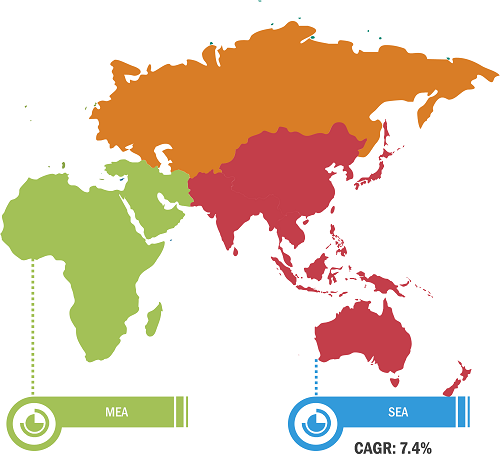Increasing Health Concerns to Drive Middle East & Southeast Asia Dietary Supplements Market Growth During 2021–2031
According to our latest market study on “Middle East & Southeast Asia Dietary Supplements Market Forecast to 2031 – Regional and Country Share, Trend, and Growth Opportunity Analysis – by Form and Packaging Type,” the market is projected to grow from US$ 17.04 billion in 2023 to US$ 30.72 billion by 2031. The market is expected to record a CAGR of 7.6% from 2023 to 2031. The report includes growth prospects in light of the current Middle East & Southeast Asia dietary supplements market trends and driving factors influencing the market growth.
Dietary supplements including vitamin, mineral, protein, probiotic, and dietary fiber are ingested to regular diet to provide additional nutrients to the body. They help meet daily requirements of essential nutrients and meet specific health concerns such as vitamin and mineral deficiency, digestive problems, joint and bone disorders, and skin issues. Over the past few years, people are increasingly concentrating on health and wellness due to stagnant and hectic lifestyles. People are participating in physical activities such as running, gym, yoga, swimming, and dancing to tackle regular work-related stress, fatigue, and prevent diseases such as obesity, diabetes, and heart problems. In addition, people are investing in dietary supplements that ensure overall wellness and meet daily nutritional requirements. After the COVID-19 outbreak, the demand for dietary supplements in Southeast Asia and the Middle East has increased two-fold as people increasingly prioritize fitness, mobility, immunity, and overall well-being. Thus, all these factors are significantly driving the Middle East & Southeast Asia dietary supplements market growth.
Middle East & Southeast Asia Dietary Supplements Market Breakdown – by Region

Middle East & Southeast Asia Dietary Supplements Market 2031
Download Free SampleMiddle East & Southeast Asia Dietary Supplements Market Size and Forecast (2021 - 2031), Regional Share, Trend, and Growth Opportunity Analysis Report Coverage: By Form (Tablets, Capsules, Softgels, Powders, Gummies, Liquids, and Others), Packaging Type (Bottles and Jars, Tins and Cans, Stand Up Pouches and Cartons, Sachets and Other Pouches, and Blisters and Strips), and Geography
Based on packaging type, the Middle East & Southeast Asia dietary supplements market is segmented into bottles and jars, tins and cans, stand up pouches and cartons, sachets and other pouches, and blisters and strips. The blisters and strips segment is expected to register significant growth over the coming years. Manufacturers are replacing traditional, rigid supplement bottles with blisters and strips as they are individually packed, easy to carry, travel-friendly, and ensure product safety from damage during transportation and warehousing. Thus, all these factors are significantly driving the growth of the blisters and strips segment in the Middle East & Southeast Asia dietary supplements market.
The manufacturers are also shifting toward sachets and pouches to package supplements such as powders, RTD beverages, vitamin shots, and liquid supplements that are individually portioned based on dosage quantity, which prevents large storage space and eliminates the hassle of portioning the supplements. Thus, innovative packaging of dietary supplements is attracting a large number of consumers, which is encouraging manufacturers to expand their geographical presence. For instance, Korea-based dietary supplement brand Vita Drops announced the launch of liquid supplement sachets by expanding across Southeast Asia.
Consumers are rapidly shifting toward e-commerce as they offer convenience of shopping multiple products remotely and heavy discounts and offers. E-pharmacies and online health stores are witnessing immense demand for dietary supplements that provide general wellness. The surging demand for dietary supplements from online shopping platforms is expected to drive the Middle East & Southeast Asia dietary supplements market over the forecast period.
Haleon group of companies, Herbalife, Life-Space Group Pty Ltd, Swisse Wellness Pty Ltd, GNC, Meridlife, ALLNATURE, Blackmores, Bayer AG, and 21st Century Singapore are among the major players profiled in the Middle East & Southeast Asia dietary supplements market report. Market players focus on developing high-quality products to fulfill the varied requirements of consumers. Moreover, these key players adopt strategic development initiatives such as product development, collaborations, and partnerships to expand their market presence.
The geographic scope of the Middle East & Southeast Asia dietary supplements market report entails Thailand, Vietnam, Malaysia, the Philippines, Indonesia, and Singapore. The Philippines is expected to register the highest CAGR from 2023-2031. Moreover, Indonesia accounted for a significant Middle East & Southeast Asia dietary supplements market share in 2023. The rising demand for cosmetic and beauty dietary supplements that focus on the beauty-from-within concept is expected to be one of the rapidly growing Middle East & Southeast Asia market trend over the coming years.
Middle East & Southeast Asia Dietary Supplements Market Report Segmentation:
The Middle East & Southeast Asia dietary supplements market analysis has been carried out by considering the following segments: form and packaging type. Based on form, the market is segmented into tablets, capsules, softgels, powders, gummies, liquids, and others. In terms of packaging type, the market is segmented into bottles and jars, tins and cans, stand up pouches and cartons, sachets and other pouches, and blisters and strips. The bottles and jars segment dominated the Middle East & Southeast Asia dietary supplements market share in 2023, and the stand up pouches and cartons segment is projected to register the fastest CAGR from 2023 to 2031.
Contact Us
Phone: +1-646-491-9876
Email Id: sales@theinsightpartners.com